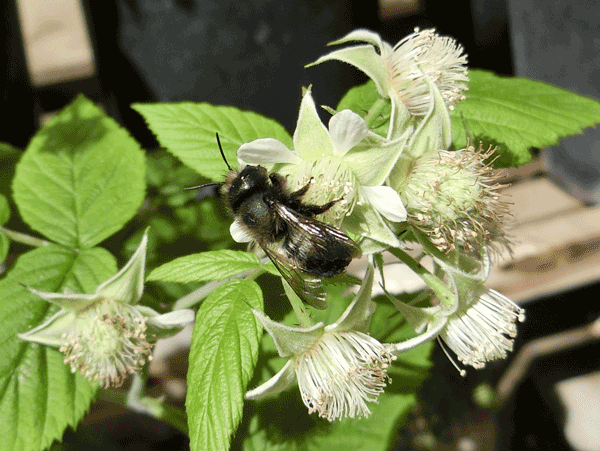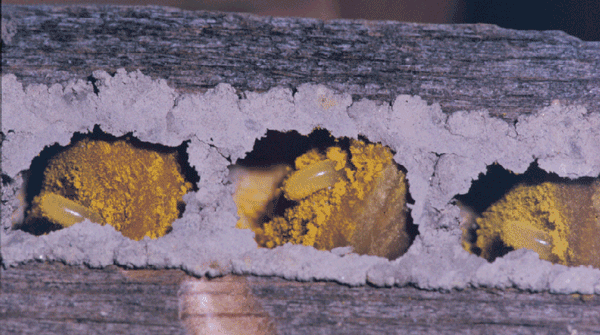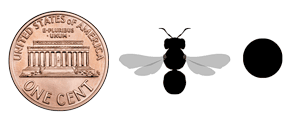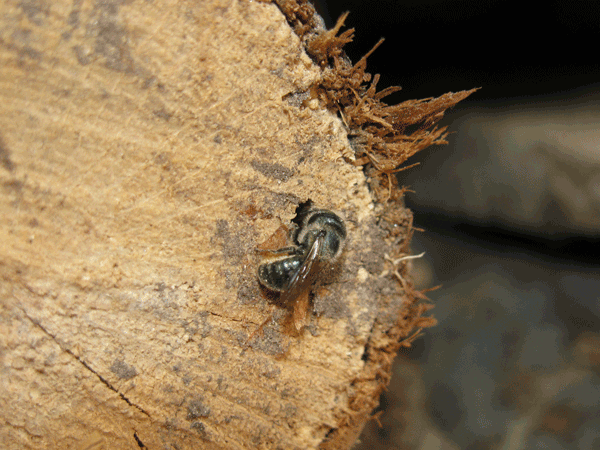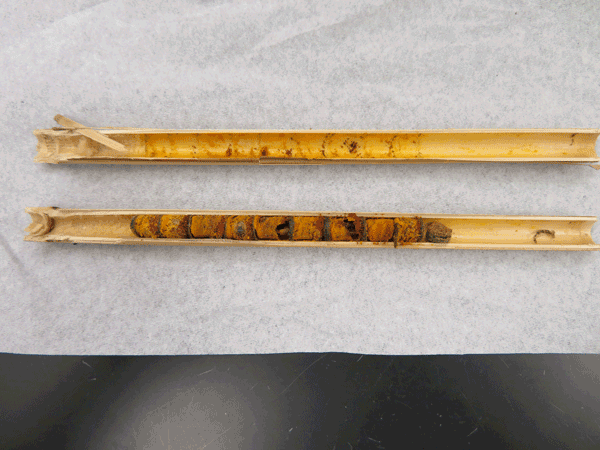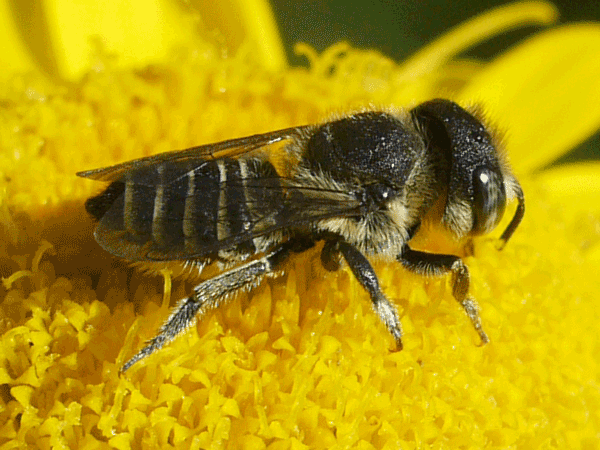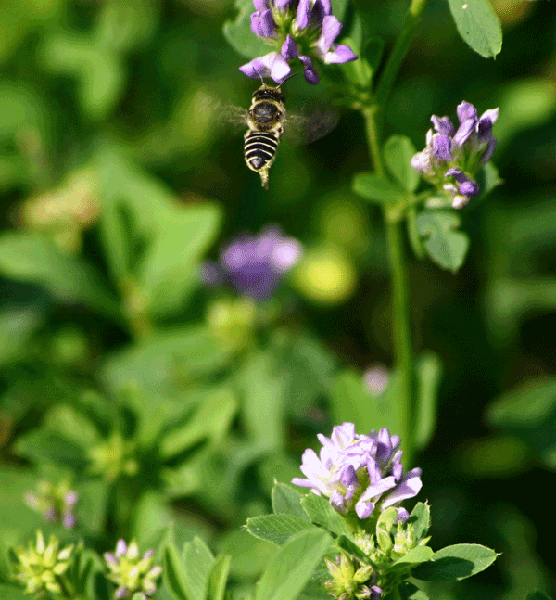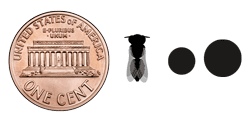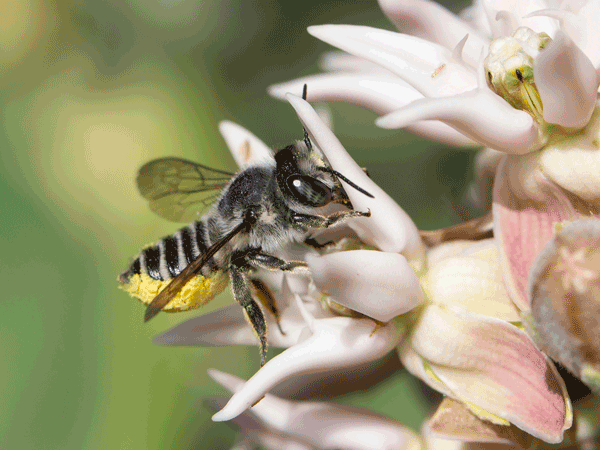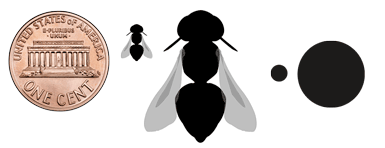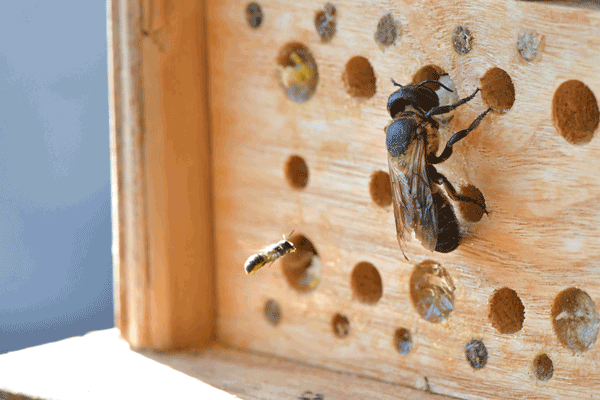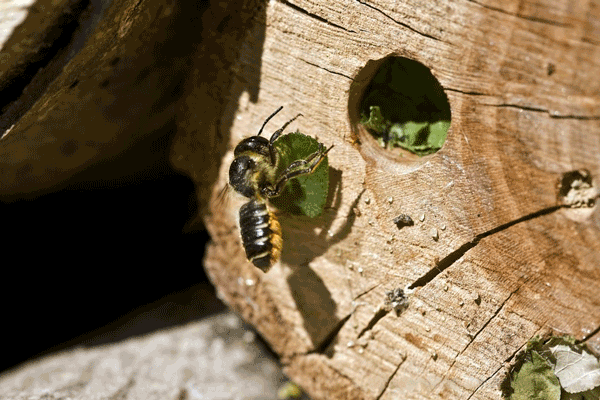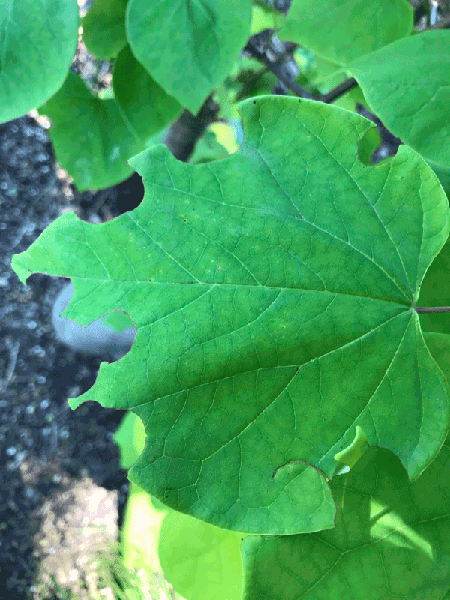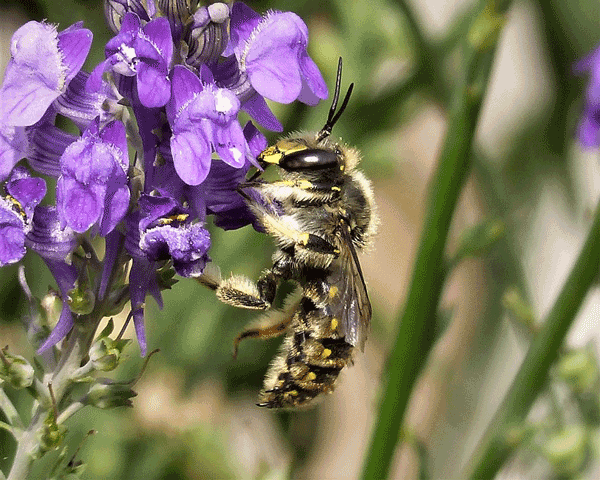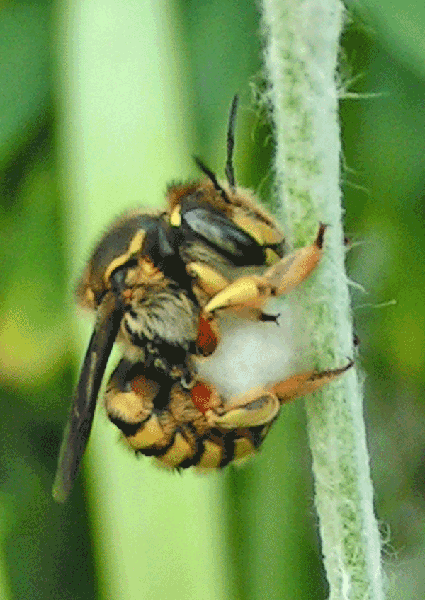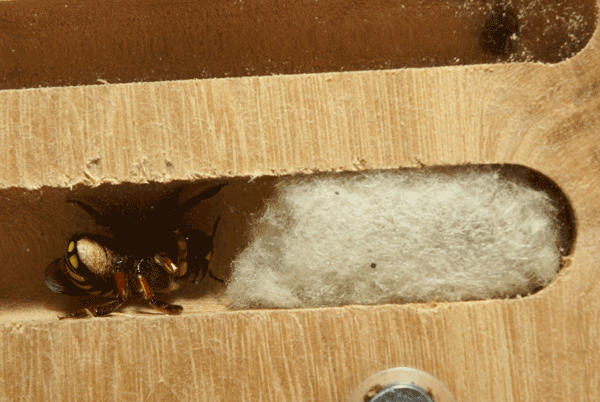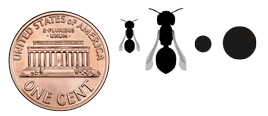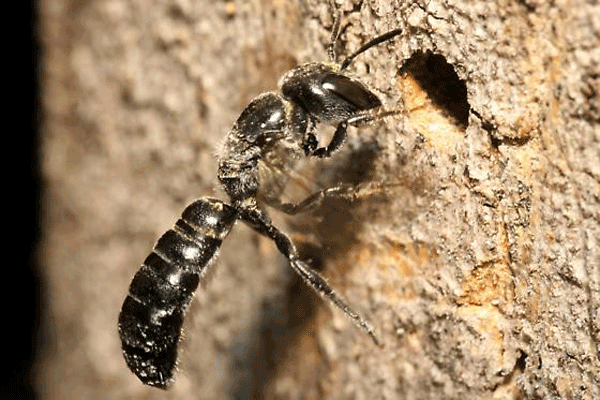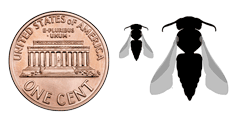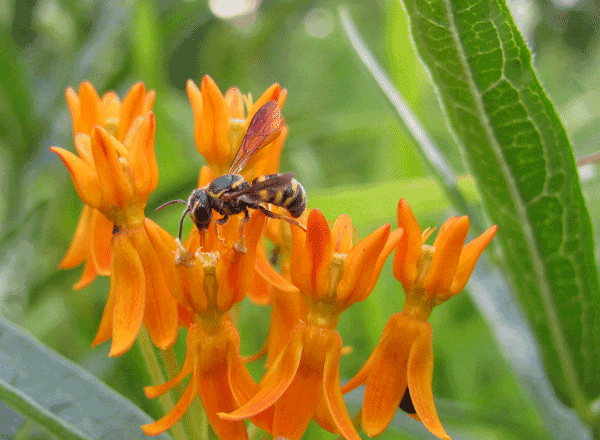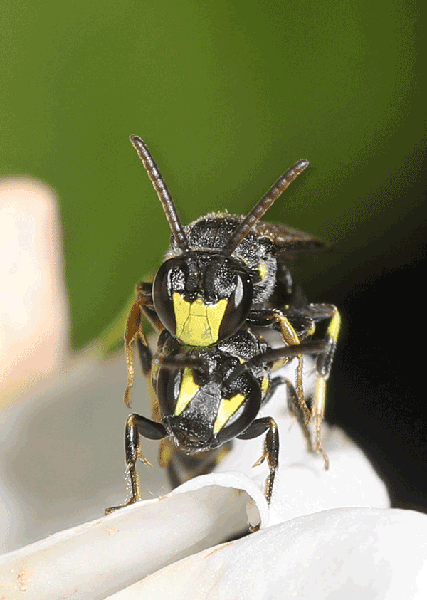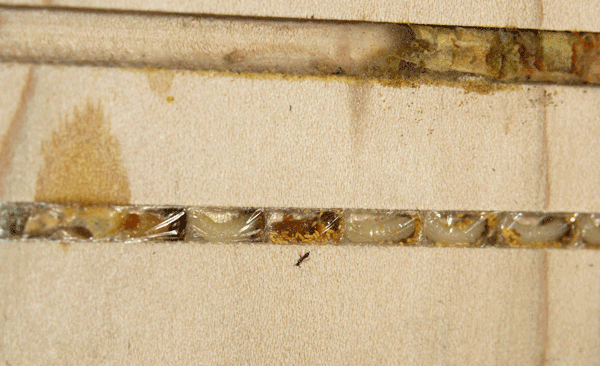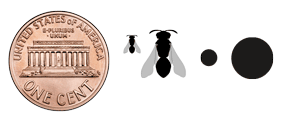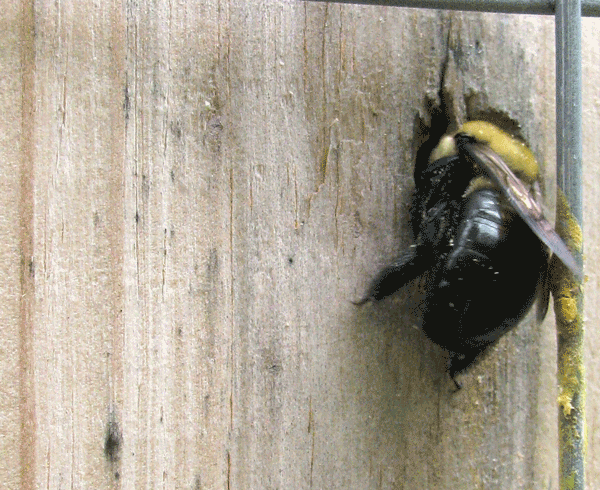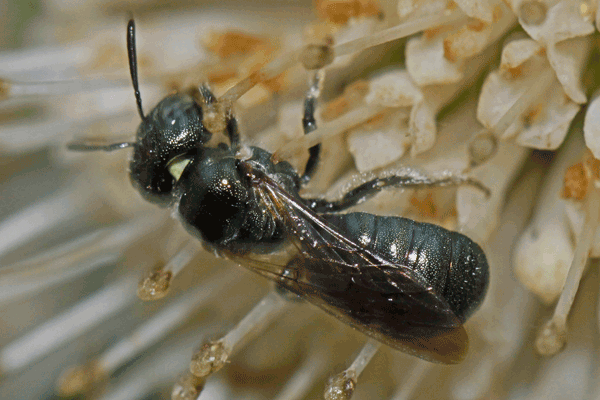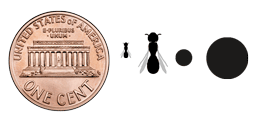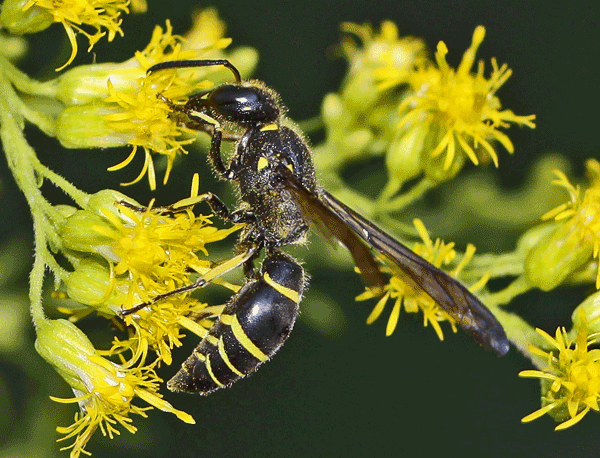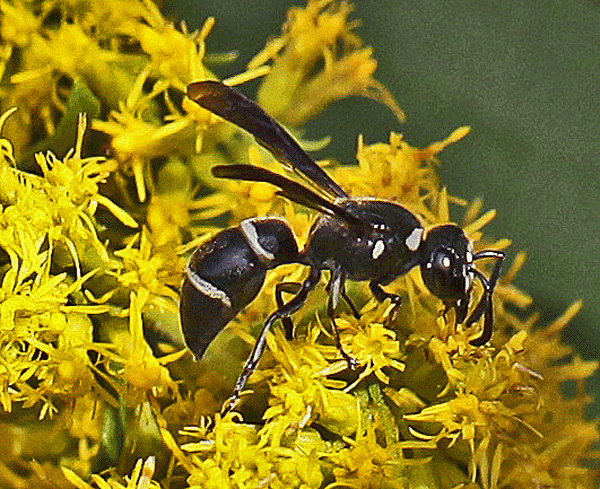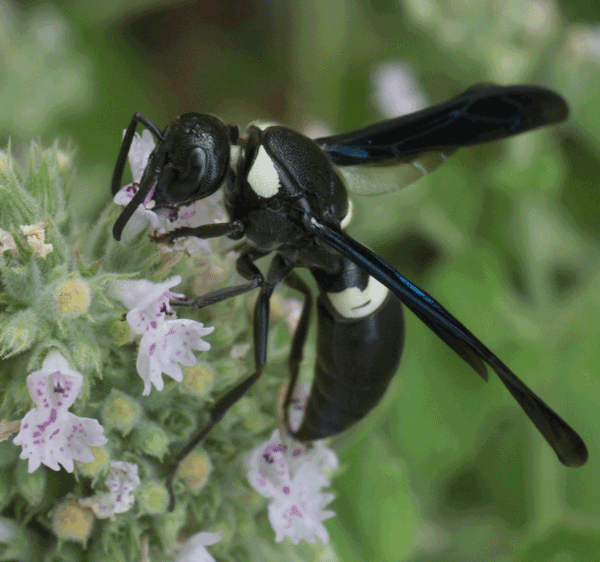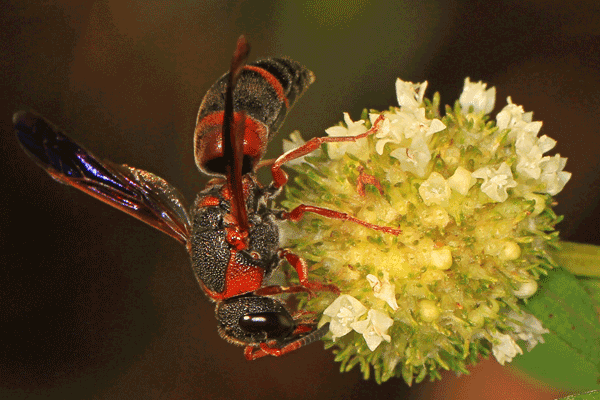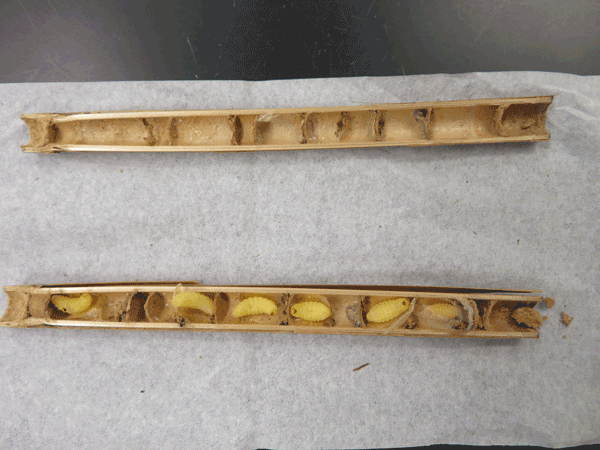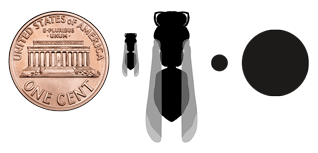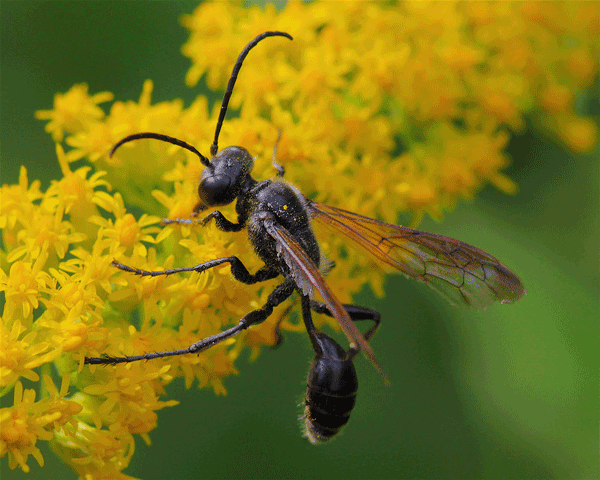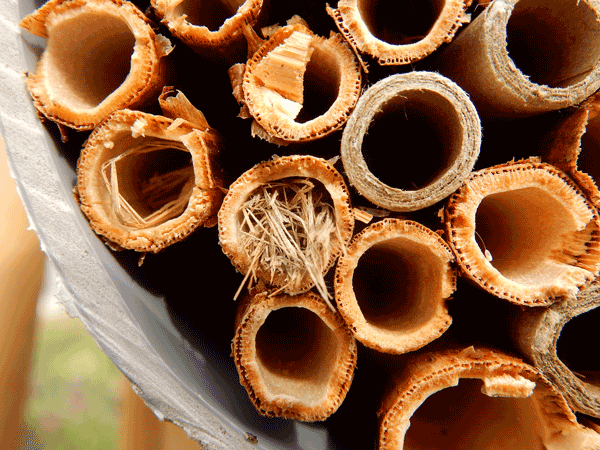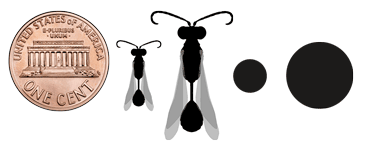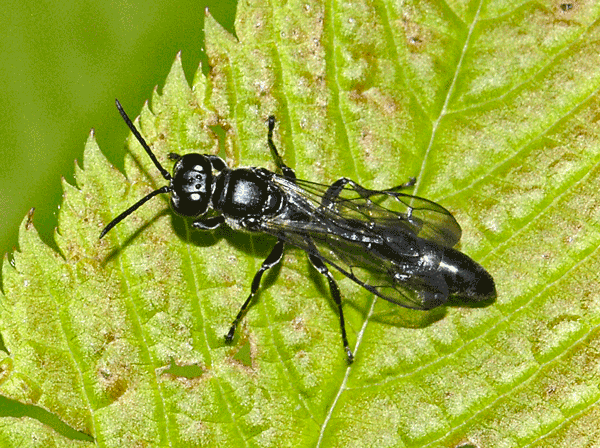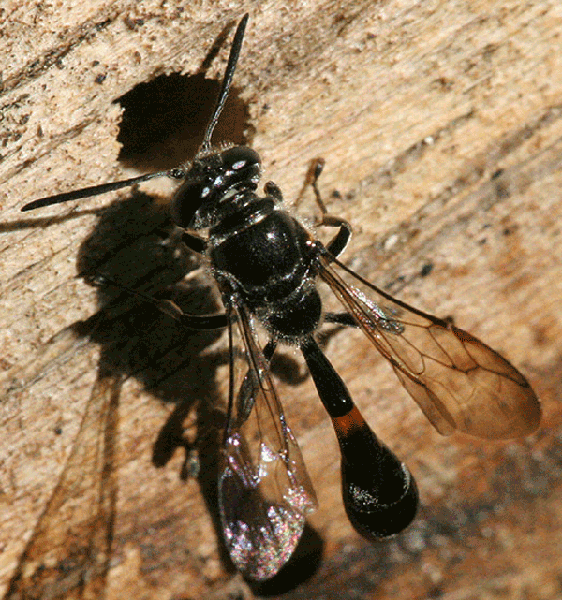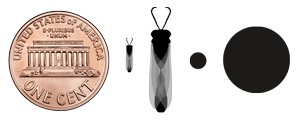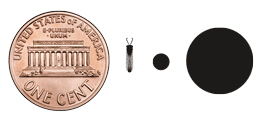This section highlights some of the common occupants of bee hotels in North Carolina and their nesting requirements. It also details the seasons when adults are most often active (foraging and building nests). Body sizes and tunnel diameters are illustrated to scale.
Family Megachilidae
Most bee species that occupy bee hotels are members of the family Megachilidae, a group that includes mason bees, resin bees, leafcutting bees, and wool carder bees. Most members of this family share a noteworthy characteristic: The female bees transport pollen on a brush of hairs (scopa) on their belly (Figure 4), rather than on their legs as most other bees do. In addition, a few parasitic “cuckoo bees” lay their eggs in the nests of other megachilids but cannot carry pollen themselves.
Blue Orchard Bee (Osmia lignaria)
One of the most recognizable residents of bee hotels is the orchard mason bee, also known as the blue orchard bee (BOB) (Figure 5 and Figure 6). This native species has been managed commercially in North America since the 1990s (Mader et al. 2010). Although they visit many kinds of flowers, BOBs have a strong preference for flowers of spring-blooming fruit trees and redbuds. BOBs are reared for commercial pollination in large nest blocks and are transported to spring-flowering crops such as almonds, apples, cherries, and peaches. Although BOBs are widely available for purchase through garden and bee supply catalogs, home gardeners rarely need to purchase the bees. If conditions are suitable, local wild populations will occupy bee hotels.
- Generations per year: one
- Peak activity: Spring (March–May)
- Favorite flowers in North Carolina: apple, ash, blackberry, boxelder, oak, redbud, willow (Kraemer and Favi 2005; Kraemer et al. 2014)
- Natural nest substrate: abandoned tunnels drilled by other insects (often beetles) in deadwood or soil (Krombein 1967; Cane 1991; Rau 1937)
- Construction materials: mud
- Tunnel diameter: ideal: 19/64″ (7.5 mm); range: 1/4″–1/2″ (6–13 mm) (Kraemer et al. 2014; Krombein 1967; Bosch and Kemp 2001)
- Body size: (9–11 mm)
- Recognition: dark metallic blue color, relatively large body size compared to other mason bees, and use of mud partitions (Figure 5, Figure 6)
Other Mason Bees (Genus Osmia)
In North Carolina, the genus Osmia includes not only the BOB, but 21 other species, three of which are introduced (Russo 2016). Several of these species are common residents in bee hotels. In the eastern U.S., populations of native mason bees (including the BOB) have declined over the past two decades, while the introduced Taurus mason bee (Osmia taurus) has become more abundant (Russo 2016; LeCroy et al. 2020).
- Generations per year: one
- Peak activity: Spring and summer (March–June)
- Favorite flowers in North Carolina: varies by species; most have broad diets, several are common on white clover
- Natural nest substrate: abandoned tunnels drilled by other insects in deadwood or soil; hollow stems (Cane et al. 2007) (see Figure 7)
- Construction materials: varies by species; mud, leaf pulp, small pebbles, sand grains, and wood fibers scraped from the nest interior (Cane et al. 2007) (see Figure 8)
- Tunnel diameter: 3/16″–5/16″ (3.4–8 mm) (MacIvor and Packer 2015; Krombein 1967)
- Body size: (7–16 mm)
- Recognition: Most native Osmia species are metallic dark blue to blue-green; the two most common introduced species (Osmia cornifrons and O. taurus) are golden-brown in color and similar in size to honey bees and BOBs.
Alfalfa Leafcutting Bee (Megachile rotundata)
The alfalfa leafcutting bee (ALB; Figure 9, Figure 10) is another one of the few solitary bee species managed intensively for commercial agriculture (Pitts-Singer and Cane 2011). Originating from Eurasia (Bohart 1972), the ALB was introduced into the US by the 1940s (Stephen 2003), and its pollination services augment alfalfa seed production (Pitts-Singer and James 2008). Alfalfa is grown globally for hay to feed livestock, especially dairy cows. ALBs are efficient pollinators of alfalfa (Cane 2002) and are also used in western Canada for producing hybrid canola seed. They can also pollinate species of annual clover (Maeta and Kitamura 2007; Richards 1995), lowbush blueberries (Javorek et al. 2002), and cranberries (Cane and Schiffhauer 2003), and have been used to pollinate crops in confined spaces such as glasshouses (Cane 2002; Maeta and Adachi 2005) and cages (Soroka et al. 2001; Tepedino 1996).
- Generations per year: one or two
- Peak activity: late spring to summer (April–July)
- Favorite flowers: ALBs have broad diets and are often found on clovers and wildflowers; in commercial seed production, they pollinate carrots, canola, and alfalfa (Pitts-Singer and Cane 2011).
- Construction materials: leaf pieces of various species, including alfalfa, buckwheat, rose, and clover (Horne 1995; MacIvor 2016).
- Tunnel diameter: 13⁄64″–9⁄32″ (5–7 mm) (Gerber and Klostermeyer 1972; Pitts-Singer and Cane 2011)
- Body size: (7–9 mm)
Other Megachile
Megachile species, also known as leafcutting bees and resin bees, are named for their use of leaves and plant resins to outfit their nests (Figures 11, 12, 13, 14, and 15). In addition to the alfalfa leafcutting bee, there are 36 other species in North Carolina, two of which are introduced (Russo 2016). Leafcutting bees are diverse in nesting habits and foraging material. Some cut circles out of leaves from plants such as roses, redbud, and grape to line their nests (MacIvor 2016), while others use resin or chewed leaf pulp. (See Appendix 2 for a list of plants used.) Many Megachile species have multiple generations per year.
The largest Megachile species in the state is the introduced giant resin bee (Megachile sculpturalis, Figure 12). This species is native to eastern Asia but was accidentally introduced to the United States and Europe. It was first noticed in the United States in 1994, on the NC State University campus, and has spread throughout the eastern and midwestern states (Mangum and Brooks 1997; Parys et al. 2015; Polidori and Sánchez-Fernández 2020). The giant resin bee can be an aggressive occupant of bee hotels (and carpenter bee tunnels), sometimes immobilizing its victims with sticky resin (Roulston and Malfi 2012; Laport and Minckley 2012).
- Peak activity: Summer and fall (May–November)
- Favorite flowers in North Carolina: many species, including asters, legumes, sunflowers, evening primroses
- Natural nest substrate: hollow stems, holes in dead wood, cracks, and crevices; some nest in the ground
- Construction materials: resin, petals, leaves, leaf pieces, or leaf pulp, sometimes mixed with mud or sand. Favorite leaf species include roses, redbud, and grape; see Appendix 3.
- Tunnel diameter: 1/8″–1/2″ (3.2–12.7 mm)
- Body size: (7–25 mm)
Wool Carder Bees (Anthidium)
Wool carder bees (Figures 16, 17, and 18) in North Carolina use plant fibers to build their nest interior (Krombein 1967). Their nesting cavities often appear to be stuffed with wool (actually plant fibers), which makes them easy to identify (Figures 17 and 18).
Three species of Anthidium are known in North Carolina, one of which is native. Nests of the native species, A. maculifrons, are not well known and are likely to be in soil, not bee hotels (Gonzalez and Griswold 2013). One of the introduced species, Anthidium manicatum, also known as the European wool carder bee, can be aggressive toward other bees (but not humans). Males claim territories around flowers and defend those territories against all other insects except females of the same species. Although the males cannot sting, they can injure or kill intruders by “stabbing” them with spines on their abdomens (Wirtz et al. 1988; Wirtz et al. 1992).
- Peak activity: Summer and fall (May–October)
- Favorite flowers in North Carolina: deadnettles, legumes, mints, and figworts (Hicks 2011)
- Construction materials: plant fibers, mud, resin from conifers, pebbles (Krombein 1967)
- Tunnel diameter: 3/8″–5/8″ (9.5–15.6 mm)
- Body size: (8–17 mm)
- Recognition: These bees are yellow and black. Female Anthidium species, like other members of the family Megachilidae, carry pollen using hairs located on the underside of their abdomens, so their bellies often look yellow while foraging.
Hoplitis and Heriades
These two genera of resin bees and mason bees are closely related to Osmia mason bees. They are small and relatively understudied as pollinators. Ten species (seven Hoplitis, three Heriades) occur in North Carolina and may occasionally turn up in bee hotels (Figures 19 and 20). (Most traits listed below are from Krombein 1967).
Table 1. Characteristics of Hoplitis and Heriades.
| Characteristic | Hoplitis | Heriades |
|---|---|---|
| Peak activity | Spring and summer (April–July, occasionally into October) | |
| Favorite flowers in North Carolina | Some species are common on clover; others are specialists on Nemophila (baby blue eyes), Phacelia, or Amorpha (false indigo bush) | |
| Natural nest substrate | Abandoned tunnels drilled by other insects in deadwood; hollow or pithy stems | Pithy stems or twigs |
| Construction materials | Varies by species; mud, leaf pulp, pebbles | Resin, sand |
| Tunnel diameter | 1/8″–1/4″ (2.8–6.4 mm) | |
| Body size | 6–12 mm (Hoplitis) | 6–7 mm (Heriades) |
Chelostoma philadelphi
This small mason bee (Figure 21) is the only member of its genus in North Carolina. Mother bees collect pollen from mock orange (Philadelphus), and possibly other plants, to feed their larvae (Robertson 1929; Fowler 2016; Mach and Potter 2018). At least in Raleigh, North Carolina, this species is a fairly common urban resident, but its life history has not been extensively studied.
-
Generations per year: one
-
Peak activity: spring (April–June)
-
Favorite flowers in North Carolina: mock orange (Philadelphus), raspberry (Rozen and Go 2015; Mach and Potter 2018)
-
Natural nest substrate: abandoned tunnels drilled by beetles in deadwood (Rozen and Go 2015)
-
Construction materials: mud, leaf pulp, small pebbles (Krombein 1967; Rozen and Go 2015)
-
Tunnel diameter: 1/8″ (2–3 mm) (Krombein 1967; Rozen and Go 2015)
-
Body size: (8 mm)
Coelioxys
Also known as cuckoo leafcutting bees, Coelioxys (seel-ee-OX-iss) bees lay their eggs in the nests of other bees (Figure 22). To the extent that their habits are known, the 16 species in North Carolina target nests of leafcutting bees (Megachile). A female Coelioxys may wait near the nest entrance until the resident Megachile leaves. She then enters the nest, uses the pointy tip of her abdomen to slit the wall of the unfinished nest cell (Danforth et al. 2019), and lays an egg into the slit (Graenicher 1927).
When the cuckoo bee larva hatches, it starts eating the pollen provision collected by the Megachile mom, and eventually kills the Megachile larva (Danforth et al. 2019; Graenicher 1927). Cuckoo bees are not equipped with pollen-carrying hairs or other tools needed to build a nest and stock it with pollen, so they have no choice but to parasitize existing nests. Occasionally, cuckoo bees can cause their host population to crash (Cane et al. 1996). More often, though, cuckoo bees are relatively rare and parasitize only a small percentage of nest cells (O’Neill and O’Neill 2016; Danforth et al. 2019).
-
Generations per year: up to three (Baker et al. 1985)
-
Peak activity: late summer (present April–October)
-
Favorite flowers in North Carolina: Coelioxys bees are generalists, found visiting a range of flowers such as sumac, holly, and goldenrod. Their larvae, of course, eat whatever pollen their Megachile host collected.
-
Natural nest substrate: Megachile nests, including those built with resin, leaf pulp, or leaf pieces.
-
Body size: (7–16 mm)
-
Recognition: These bees are usually dark with white hair stripes—similar to many leafcutting bees—but the pointy rear end is a giveaway (Figure 22). The tip of the abdomen is most pointed in females (who also lack a scopa), but even males are narrower than their non-parasitic relatives.
Stelis
Stelis bees (Figure 23) are also cuckoo bees, with a lifestyle similar to that of Coelioxys. The seven species in North Carolina parasitize nests of Megachile, Osmia, Hoplitis, and Heriades.
- Generations per year: one to several
- Peak activity: summer (May–June)
- Favorite flowers in North Carolina: Adults will visit many flowers for nectar, including sweet clovers and milkweeds; larvae eat whatever pollen was provided by the host.
- Natural nest substrate: nests of Megachile, Osmia, Hoplitis, and Heriades, including those built with resin and leaf pulp.
- Body size: (5–11 mm)
- Recognition: The most common species in the piedmont is Stelis louisae, a slender, yellow-and-black bee. Several other species of Stelis are black with more subtle ivory marks on the abdomen.
Family Colletidae
Bees in the family Colletidae are also known as cellophane or polyester bees because they construct a silky, waterproof lining in each nest cell. The lining comes from a combination of glandular secretions that the bee applies in liquid form, which then solidify into polyester or a mixture of polyester and silk (Almeida 2008). Although most members of this family are stout, fuzzy, ground-nesting bees, the genus Hylaeus includes small, sleek bees who nest in twigs, stems, and other cavities (Figures 24, 25, and 26).
Yellow-Faced Bees (Hylaeus)
Yellow-faced bees are named for the bright yellow coloring on their faces (Figure 24). These bees are quite small and wasp-like in appearance, lacking pollen-collecting hairs found on other bee species. Instead, female Hylaeus carry pollen and nectar back to the nest in their crop (a stomach-like organ). Fourteen species of Hylaeus have been found in North Carolina.
-
Peak activity: Summer (present May–October)
-
Favorite flowers in North Carolina: general; many wildflowers
-
Natural nest substrate: hollow stems, with and without pith
-
Construction materials: spit
-
Tunnel diameter: 1/8″–5/16″ (3–8 mm)
- Body size: (3.5–9 mm)
Family Apidae
This large and varied bee family includes honey bees, bumble bees, and carpenter bees, among others. Most members of this family in North Carolina nest in the soil, and thus do not use bee hotels. Some bumble bees (genus Bombus) do nest in aboveground cavities such as birdhouses or wall voids, but they are not attracted to bee hotels. In the eastern US, bumble bees rarely use purpose-made nesting structures, although a couple of species regularly occupy birdhouses that contain old birds’ nests.
Large carpenter bees (genus Xylocopa, Figure 27) are notorious for drilling their own nesting tunnels into wood. Although carpenter bees might occasionally use bee hotels if these include large-diameter holes (at least 3/8″ or 1 cm) (Jenkins and Matthews 2004), they are not frequent residents. A bee hotel is unlikely to lure carpenter bees away from more spacious nesting opportunities in decks, porches, and sheds.
Small Carpenter Bees (Ceratina)
Small carpenter bees are close cousins of large carpenter bees but differ in size and habit (Figures 28 and 29). Six species occur in North Carolina, the largest barely more than 1/4″ long. They cannot damage wooden structures. Instead, they nest inside stems with soft, pithy centers (Figure 29); the bees burrow into the pith to make nesting space. They can only use stems that are already damaged to expose the pith.
Because small carpenter bees use pith itself as a construction material inside the nest, the empty blocks and reeds used in most bee hotels are not attractive to them. However, by incorporating pithy stems as nesting materials in the hotel, or by simply managing suitable plants (see below) on your property, you may be able to support and observe these species. They may prefer stems that are vertically oriented.
-
Peak activity: Year-round, especially June–September
-
Favorite flowers in North Carolina: small carpenter bees visit a wide variety of flowers, including cucurbits, blackberries, mustards, and others
-
Natural nest substrate: pithy stems such as elder, sumac, rose, blackberry, and raspberry; selected stems are usually vertical
-
Construction materials: pith from stem interior
-
Tunnel diameter: 1/8″–5/16″ (2.2–7 mm)
-
Body size: (3–8 mm)
-
Recognition: Small carpenter bees are metallic blue to blue-green, similar in color to many mason bees. The slender body shape and relative lack of hair sets the small carpenter bees apart. You’ll never see them carrying pollen on their bellies—only on their legs. While foraging away from the nest, they might be confused with metallic sweat bees, but the latter do not nest in stems.
Solitary Wasps
You might notice some wasps nesting in your bee hotel. Native solitary wasps are pollinators as well as predators of garden pests such as caterpillars and crickets, which they paralyze and store in cavities to feed their young (Krombein 1967). Although bees are the most efficient pollinators of many plants, solitary wasps also visit flowers to drink nectar, and deposit some pollen in the process (Willmer et al. 2017; Rader et al. 2016). Cavity-nesting wasps also have potential to control pest insects: A study in New Zealand fruit orchards found that a single hotel’s worth of mason wasps (64 nests) collected more than 3,000 caterpillars in just 18 days (Harris 1994). The wasps don’t always focus on pest species, though, making them somewhat unreliable gardeners’ assistants (Wearing and Harris 1999, 2005). Even at their least helpful, solitary wasps are less aggressive than their social counterparts (such as yellowjackets, paper wasps, and hornets) and thus are unlikely to sting you.
Cavity-nesting wasps are diverse and come in a variety of sizes, shapes, and colors. The most common wasps in bee hotels in the southeastern U.S. include mason wasps and potter wasps, thread-waisted wasps, and square-headed wasps (Crabrionidae) (Jenkins and Matthews 2004). These wasps tend to be most active during summer and early fall, and typically have multiple generations per year (Jenkins and Matthews 2004; Krombein 1967). Appendix 5 lists some books where you can learn more about the diversity and biology of common wasps.
Mason Wasps
Mason wasps (Figures 30, 31, 32, 33, and 34) are named for their use of sand and mud to construct their nest walls. These wasps are in the family Vespidae—which also includes social hornets, yellowjackets, and paper wasps—but the mason wasps are solitary and belong to a distinct subfamily (Eumeninae). Mason wasps typically have two or more generations per year (Krombein 1967). Many are predators of leaf-eating caterpillars, and some feed on beetle larvae (Krombein 1967).
Mason wasps vary widely in body size, color, and hole-size preferences for nesting. For example, Pachodynerus erynnis and Ancistrocerus species prefer to nest with hole diameters between 3/16 and 1/4″ (4.8 to 6.4 mm). Monobia quadridens, the largest mason wasp in the eastern US, uses 1/2″ (12.7 mm) diameter holes (Krombein 1967; Jenkins and Matthews 2004). In general, potter and mason wasps are active in North Carolina from May through October (Jenkins and Matthews 2004).
-
Peak activity: Summer and fall (May–October)
-
Natural nest substrate: old carpenter bee holes, mining bee cavities in clay (Krombein 1967)
-
Construction materials: mud, sand
-
Prey: caterpillars, beetle larvae
-
Tunnel diameter: 1/8″–1/2″ (3.2–12.7 mm)
-
Body size: (7–21 mm)
Grass-Carrying Wasps
The nests of grass-carrying wasps (Isodontia, Figure 35) are easily identified by tufts of grass protruding from their entrances (Figure 36). These wasps belong to the family Sphecidae, or thread-waisted wasps. Three species of Isodontia have been found nesting in bee hotels in the eastern US (Krombein 1967; Jenkins and Matthews 2004), of which two are common in North Carolina—Isodontia mexicana and Isodontia auripes. They can be seen flying while carrying grass blades to their nests.
-
Generations per year: 1–2 (Krombein 1967)
-
Peak activity: Summer (present April–October)
-
Natural nest substrate: hollow stems, cavities in wood, abandoned carpenter bee nests, even pitcher plants! (Rau 1935; Krombein 1967)
-
Construction materials: grass, strips of soft bark, other plant fibers (Jenkins and Matthews 2004; Krombein 1967)
-
Prey: crickets, katydids (Krombein 1967; Jenkins and Matthews 2004)
-
Tunnel diameter: 1/4″–1/2″ (6.4–12.7 mm) (Jenkins and Matthews 2004)
-
Body size: (11–20 mm)
-
Recognition: These wasps are black and shiny, with smoky red-brown wings and a long, thread-like waist. Isodontia mexicana is all black, whereas Isodontia auripes has golden-brown legs. Other members of the family Sphecidae share this body plan, but nest in the ground.
Square-Headed Wasps
Square-headed wasps are named for their bulky heads, and are members of the family Crabronidae, subfamily Crabroninae (Pulawski 2021). Although many members of this group nest in the ground, a few are notable bee hotel residents.
Trypoxylon (Figures 37 and 38) are also called keyhole wasps because they use a variety of cavities for nesting, including nail holes and keyholes (Bohart and Menke 1976). The well-known organ pipe mud daubers also belong to this genus but construct free-standing nests from mud rather than seek pre-existing cavities (Bohart and Menke 1976). Solierella plenoculoides are small wasps that hunt freshly hatched grasshoppers and lack a common name.
Table 2. Characteristics of Trypoxylon and Solierella plenoculoides.
| Characteristic | Trypoxylon | Solierella plenoculoides |
|---|---|---|
| Generations per year | one, two, or more (Krombein 1967; Jenkins and Matthews 2004) | two (Jenkins and Matthews 2004) |
| Peak activity | Summer (present April–August) | |
| Natural nest substrate | abandoned beetle borings, old mud dauber, and paper wasp nests (Jenkins and Matthews 2004; Krombein 1967) | goldenrod galls, twigs, stems (Krombein et al. 1951; Krombein et al. 1979; Kurczewski 1967) |
| Construction materials | mud (Jenkins and Matthews 2004; Bohart and Menke 1976) | sand, bark, twigs, pebbles, etc. (Jenkins and Matthews 2004; Boggs 1968) |
| Prey | spiders (Bohart and Menke 1976; Jenkins and Matthews 2004; Krombein 1967) | immature grasshoppers (Jenkins and Matthews 2004; Kurczewski 1967; Bohart and Menke 1976) |
| Tunnel diameter | 1/8″–1/2″ (3.2–12.7 mm) (Jenkins and Matthews 2004; Krombein 1959; Krombein 1967; Boggs 1968) | 1/8″–1/2″ (3.2–12.7 mm) (Jenkins and Matthews 2004; Krombein 1959; Krombein 1967; Boggs 1968) |
| Body size | (5–16 mm) (Sandhouse 1940) | (5–6 mm) (Boggs 1968) |
Publication date: July 6, 2022
AG-915
Other Publications in How to Manage a Successful Bee Hotel
- What is a Bee Hotel?
- Meet the Residents
- Bee Hotel Design and Placement
- What If Bee Hotels Aren’t Actually Good for Bees?
- Appendix 1. Bee Hotel Checklist
- Appendix 2. Plants with Leaves and Fibers Used as Construction Materials in the Nest Interior
- Appendix 3. Plants that Produce Hollow or Pithy Twigs and Stems Used by Nesting Bees in Eastern North America
- Appendix 4. Building Plans for a Simple Bee Hotel Shelter
- Appendix 5. Additional Resources
N.C. Cooperative Extension prohibits discrimination and harassment regardless of age, color, disability, family and marital status, gender identity, national origin, political beliefs, race, religion, sex (including pregnancy), sexual orientation and veteran status.


